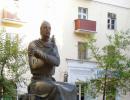Conjugation of verbs with unstressed personal endings. How to determine the conjugation of a verb with an unstressed ending? How to determine verb conjugation using personal endings
What personal ending should be written for this or that part of speech? This question arises quite often among schoolchildren, but only if the last syllable of a word is in an unstressed position. After all, it is in such situations that it is very difficult to hear the letter that should be written at the end. This is especially true for verbs.
General information
This or that personal ending of verbs depends entirely on what conjugation it refers to given word. Knowing how to correctly identify it, you will never ask yourself a similar question again.
Personal standing in shock position
With stressed endings (personal) of verbs everything is always clear. After all, a letter standing in this position is heard as clearly as possible and is a test letter. Here are some examples: watch, seethe, create etc. As you can see, all the endings of these words are stressed, that is, they are written exactly the same way as they are heard (pronounced).
Spelling of unstressed personal endings of verbs
If the endings of verbs are in an unstressed position, then determining the correct spelling of a particular letter becomes problematic. That is why it is necessary to refer to the corresponding rule. It says that all verbs in the Russian language belong either to the first conjugation or to the second.
Conjugation first
All verbs in the infinitive form ending in -ot, -at, -et, -yat, -ity and -ut belong to the 1st conjugation: melt, dig, get wet etc. The personal ending of these words in an unstressed position has the letter “e”.
Here's an example: melting, melting, getting wet, getting wet, getting wet, getting wet, melting etc. However, in the 3rd person plural. number verbs of the 1st conjugation have the following endings: -ut or -yut. For example, dig, get wet, melt etc.

Second conjugation
All verbs that are in the infinitive and ending in -it should be classified as the 2nd conjugation: nag, be proud, pray etc. The personal endings of these words in an unstressed position have the letter “and”.
Here's an example: sawing, sawing, sawing, sawing, proud, proud, begging, begging, begging etc. However, in the 2nd conjugation they have the following endings: -at or -yat. For example: sawing, proud, begging etc.
Exceptions to the rules
Now you know which vowels should be written in the personal endings of verbs if they are in an unstressed position. To do this, you only need to determine the conjugation by putting this part of speech in an indefinite form. However, this rule has its exceptions. Let's look at them in more detail:
- Shave, lay. that these words have -it at the end, they should still be classified as the 1st conjugation, since this is an exception. Accordingly, their personal endings will have the vowel letter “e” (-yut, -ut). Here's an example: spread, spread, spread, spread etc.
- To endure, to offend, to see, to depend, to watch, to turn, to hate, to breathe, to hear, to drive, to hold. Despite the fact that these words have -et and -at at the end, they still belong to the second conjugation, since this is an exception. Accordingly, their personal endings will have the vowel letter “and” (-yat, -at). Here's an example: offend, see, dependent, look, twirl, hate, breathe, drive, hold etc.
Exception words should be memorized and remembered, since many schoolchildren make mistakes in them.

Differently conjugated words
Knowing the spelling of unstressed personal endings of verbs, you can quickly and easily compose a literate text. However, it should be noted that in school curriculum The discipline “Russian Language” pays special attention not only to conjugations and exception words, but also to lexical units that are differently conjugated. These include the following: want, run. Why are they called that? The fact is that in different persons these words can have both the ending of the first conjugation and the second:
- he runs, he wants;
- you run, you want;
- I run, I want;
- they run, they want;
- you run, you want;
- we run, we want.

Let's sum it up
To determine one or another spelling of personal endings of verbs, it is recommended to follow the scheme described below:
- Determine in what position the ending of the verb is (stressed or unstressed). If it is in shock, then it should not be checked. If in unstressed, it is necessary to continue the analysis.
- Put the verb into the infinitive (or the so-called indefinite form), and then check its ending. If the word ends in -it, then it is conjugated. Therefore, it is necessary to write the letter “and” at the end (in the third person plural - -at or -yat). Otherwise, it is necessary to continue the discussion.
- You need to check whether this verb is included in the list of exception words in -аt or -еть. If included, then it also belongs to the second conjugation, that is, the ending should be written “and”. If not included, then the first conjugation. At the end you should write “e” (in the 3rd person plural we write -yut or -ut).
Verb conjugation is a constant grammatical feature of this part of speech. The article describes ways to determine the conjugation of verbs, provides tables with clear examples various options conjugations, and also indicates exceptions to the general rules.
What is verb conjugation
Verb conjugation in Russian is a system for changing the forms of present tense verbs by numbers and persons. Verb conjugation refers to the constant grammatical features of a given part of speech. There are two main types of conjugations in the Russian language - 1st and 2nd conjugation of verbs. According to the rules, verb conjugation is determined in two ways:
- According to the stressed personal endings of present tense verbs;
- If the ending of the verb is unstressed, the conjugation is determined by the infinitive suffix (indefinite form).
How to determine verb conjugation using personal endings
To determine the conjugation of a verb with a stressed personal ending, it is enough to conjugate the word by numbers and persons. The list of personal endings of verbs 1 and 2 conjugations with examples is presented in a clear table of verb conjugations in the Russian language.
| Face | Verbs 1 conjugation | Verbs 2 conjugations | ||||
| Unit number | Mn. number | Examples of verbs 1 conjugation | Unit number | Mn. number | Examples of verbs 2 conjugations | |
| 1st | -у(-у) | -eat | I draw, I sew, I grow draw, sew, grow |
-у(-у) | -them | I will cook, buy, keep cook, buy, keep |
| 2nd | -eat | -yeah | draw, sew, grow draw, sew, grow |
-hey | -ite | cook, buy, keep prepare, buy, keep |
| 3rd | -et | -ut(s) | draws, sews, grows draw, sew, grow |
-it | -at(-yat) | cooks, buys, holds cook, buy, keep |
How to determine the conjugation of verbs with unstressed endings
To find out the conjugation of verbs with unstressed personal endings, it is necessary to form the infinitive form of the verb (infinitive) and determine the conjugation of the verb using the infinitive suffix.
Sections: Primary School
Goals:
- Teach students to determine the conjugation of a verb with an unstressed ending by solving a problem situation based on research;
- Develop the ability to justify the writing of verb endings;
- Developing the ability to listen to the opinions of others; independence in decision making.
Equipment: signal cards “Yes - No”, drawings with the image of Pochemuchka (3 pcs.), cards for the output diagram.
During the classes:
I. Organizational moment:
- Greetings.
- Recording numbers, class work.
II. Explanation of the topic of the lesson.
In this lesson, guys, we will learn to determine the conjugation of verbs with an unstressed personal ending and discover new knowledge.
III. Reviewing what has been learned about the verb.
Working with signal cards. Game "Attention".
- If the statement is true, then you show a card with a green circle, if it is false, then you show a card with a red circle and correct the error.
- A verb is a part of speech that denotes an attribute of an object and answers the questions: what to do? what to do? (No).
- Verbs change tenses (Yes).
- In a sentence, the verb is most often a predicate (Yes).
- Soft sign in 2nd person verbs singular denotes the softness of the previous consonant (No).
- Infinitive verbs answer the questions: what to do? what to do? (Yes).
- Verbs of the present and future tenses change according to persons and numbers (Yes).
- Changing verbs by person and number is called declension (No).
- Verbs have 3 conjugations (No).
IV. Development tasks:
1. Form an indefinite form from these verbs. Prove:
will decide -
decides -
2. Which of these verbs does not form the present tense in exactly the same way as the others:
(A) slander
(B) mumble
(B) chirp
(D) Twitter
(D) bother
V. Updating of new knowledge.
And now a question from Why? Remember what unstressed endings do verbs of I and II conjugations have?
Writing on the board: I reference. -u, -yu, -et, -eat, -et, -ut, -ut.
II sp.-u, -yu, -ish, - it, -im, -ite, -at, -yat.
I name the ending, and you determine the person and number of the verb with that ending.
(-ite – 2l., plural, -et – 3l., singular, -ish – 2l., singular, -ut, -yut – 3l., plural, -at , -yat – 3l., plural)
Now let's turn to the verb phrases written on the board. I’ll read it, and tell me what you noticed? (Endings are unstressed).
how much firewood
approach...to school
cut flowers
VI. Working on the lesson topic:
What do you think needs to be done to correctly write the unstressed ending of a verb?
This is the Why question. Will we be able to answer it? (No).
- So, what is the purpose of our lesson?
(It is correct to write unstressed personal endings of verbs).
- Why is this so important? (Not knowing how to write these endings correctly, we will make mistakes).
- How do you think to prove the writing of an unstressed ending? Maybe use a different verb with a stressed ending to check? (For example: I’m walking, I’m silent).
(No, since the conjugation of the first verb is unknown to us).
This means that the main thing is to find out the conjugation of the verb, and then we can easily determine which ending is written in the desired person and number. This is the answer to Whychka’s second question.
- How to determine the conjugation of a verb with an unstressed ending? (Children speak out).
- Remember, by the initial or indirect form it was possible to determine the type of ending of a noun?
(According to the initial form).
- Let's try to do the same with verbs.
- Read the following verbs to yourself.
(On the board: brighten, feed, dream, shine, fly, heal, plant, pull, dig, build).
In what form are these verbs given? (3rd person, plural, present and future tense, I and II reference)
- Why are there no past tense verbs among them?
(Do not conjugate).
- To be confirmed lexical meaning unfamiliar words.
- Let’s put the verbs in their initial form and write them in 2 columns according to conjugations:
What did you notice? (In column 2, verbs in the indefinite form have the suffix -i- and end in -it).
(Students highlight the suffixes -i-, -t-, emphasize -it). It is further concluded that in column 1 the verbs in the indefinite form end in -et, -at, -yat, -ot, -ut, -yt. Suffixes are highlighted and underlined.
VII. Drawing up a conclusion diagram on the topic.
Children at the magnetic board using cards make a conclusion diagram.
The diagram looks like this:
You probably guessed with which letter at the end verbs ending in -it will be conjugated? (With the letter i).
- Why? (Because they relate toIIconjugation).
Similarly, it is concluded that verbsIconjugations are conjugated with the letter e).
The scheme is supplemented with cards e, and.
Conclusion: on the third question Pochemuchki based on the output diagram.
-
In the following lessons we will supplement this diagram with new information.
-
Now let's get back to our examples. Let's use the knowledge we've gained. Let's explain the writing of unstressed endings of verbs.
chop wood (count from )
cut flowers (cut at)
approaching school (approach it)
Children explain the spelling of verb endings. Drawing up a reasoning algorithm.
Algorithm:
- I put it in the initial form.
- Determining the conjugation.
- I'm writing a letter.
Physical education minute.
And now, guys, stand up!
They quickly raised their hands up,
To the sides, forward, backward,
Turned right, left,
They sat down quietly and got back to work.
VIII. Consolidation of what has been learned.
Execution of exercise 455 (Ramzaeva T.G. “Russian language”, 4th grade, part 2) – check of what has been completed.
IX. Summing up the lesson.
What do you need to know to correctly write the unstressed ending of a verb? (Conjugation).
- How to determine the conjugation of verbs with unstressed personal endings? (Indefinite form).
- Which verbs of the indefinite form belong to the II conjugation? (Ending in -it).
- To the I conjugation? (Other).
X. Grading.
Topic: How to determine the conjugation of a verb with an unstressed ending.
The purpose of the lesson:
Summarize students’ knowledge of ways to determine verb conjugation;
Strengthen students' ability to determine the type, number and person of a verb;
Create an algorithm for determining verb conjugation using the indefinite form of the verb and the 3rd person form of the verb plural;
Develop the ability to form conclusions;
Develop students' speech;
Work on the development of auditory perception and on the pronunciation side of speech;
Develop attention, memory and thinking.
During the classes.
Organizing time.
How is your health?
How are you feeling?
Conjugation of verbs-?
Conjugate the verb -?
Types of conjugation.
? ?
verbs for: verbs for:
We repeated the definition of verb conjugation by ... (ending).
-Now determine the conjugation of the verbs at the end.
They scream - you fly -
Lying - in a hurry -
You stand - you play -
The first column is performed by Sayin's team, and the second column is performed by Kudera's team. Then you will exchange notebooks and check who completed the task.
III. Work on new topic(goal setting)
Guys, what question should we answer today?
How to determine the conjugation of a verb if the ending is unstressed.
Right. Read the words written on the board. (Children read)
You plant - Water -
Treat - Play -
Walking - Walking -
Put emphasis on words.
Unstressed endings.
What can you say about the words in the 1st column?
These are verbs with unstressed endings.
We need to determine the conjugation of these verbs. What do we need to do?
To determine the conjugation of a verb with an unstressed ending, you need to put it in NF.
Put the verbs into NF.
You plant - plant
Treat - treat
Walk - walk
What conjugation do these verbs belong to?
To the second conjugation.
Now put these verbs in the 3rd person plural form.
You sit down and they sit down.
What can you say about the words in the 2nd column?
How to determine the conjugation of these verbs?
You need to form the indefinite form of the verb from these verbs.
Form a NF.
Watering - watering
Walking - walking
You play - play.
You go - go. - What conjugation do these verbs belong to?
To the first conjugation.
Now put these verbs into the 3rd person plural form.
Watering - watering
Walking, walking
You play, they play.
Let's draw a conclusion. Kazyk-ool, draw a conclusion.
If the suffix is I in NF, then this is the second declension, and if the NF does not have the suffix E, then this is the first declension.
If a verb in the 3rd person plural form has the endings -ut, -ut- 1 conjugation.
If the 3rd person plural verb has the endings -at, -yat- 2nd conjugation.
Right. Well done boys. (as the work progresses, the teacher helps the students)
We will do tasks and exercises.
IV. Independent work students.
Write the verbs in 2 columns - by conjugation.
(run, joke, shoot, dream, make friends, chop, say, go)
Exercise 383, page 138.
How do you determine the conjugation of a verb with an unstressed ending? Give examples of these verbs:
Watching, watching, watching -
The conjugation of these verbs can be determined by the ending. Verbs of the second conjugation have endings –ish, -it, -im, -ite, -at (-yat). This means that these are verbs of the 2nd conjugation.
You bake, bake, bake-
The endings of these verbs are eat, -yot, -ut. These are verbs of the 1st declension.
VI. Homework.
Exercise 385, page 138.
Come up with a linguistic tale about verbs 1 and 2 conjugations.
Determine the accent. Indicate the endings. Name verbs with unstressed endings.
Lives, travels, flies, sings, fights, builds.
Is it possible to determine the conjugation of verbs with unstressed endings by ear or by the 3rd person plural? Not always:
What to do in these cases?
If the verb has an unstressed personal ending, you need:
- put the verb in the indefinite form. For example: build - build;
- determine which vowel comes before -t.
The II conjugation includes:
- all verbs are in -it (except shave, lay)",
- 7 verbs in -et: endure, twist, offend, depend, hate, see, watch;
- 4 verbs in -at: hold, hear, breathe, drive. All other verbs (na -et, -at, -ot, -ut, -yt, etc.) belong to the I conjugation.
Sample reasoning.
1. Str..m- I put the verb in an indefinite form: walk. Verb to -it, which means it is II conjugation, you need to write at the end and - let's go.
2. See..sh- form an indefinite form: see, exception verb of II conjugation, you need to write and - you'll see.
669 . Determine the conjugation of the verbs, put them in the 1st person plural.
Sample. To worry (in -it, II sp.) - to be alarmed.
Walk, offend, trust, weed, endure, delay, sow, saw off, ride, fight, lay.
670 . Put these verbs in the indefinite form and form the 3rd person singular and plural. Please note that all forms of the verb must be of the same type.
Sample. I’ll jump up - jump up (on -it, II sp.) - jump up [it] - jump up [at]; I jump up - jump up (on -at, I sp.) - jump up[et] - jump up[ut]
I’m offended, I’m offended; I declare, I declare; twist, twist 2; I answer, I will answer.
671 . Form verbs using prefixes You-. Indicate their conjugation.
Please note that verbs with prefixes belong to the same conjugation as unprefixed ones.
Sample. We look - look[im], II reference.
You stand, sit, fly, talk, sew, drink.
672 . Determine the verb conjugation. To do this, discard the attachment You-, which takes the emphasis. If the verb has an unstressed ending, determine the conjugation using the indefinite form.
Knock out..t, look..sh, drive out..t, burn out..t, withstand..sh, burn out..t.
673 . Write down the verbs you will need to tell the story using the pictures. Indicate the conjugation of verbs.

674 . Tell us (orally) about how Artyom nailed the birdhouse. Think about how you will tell, in what tone - seriously, jokingly or mockingly. And this depends on your task: let’s say you want to entertain, make the audience laugh (maybe you are this Artyom) or you want to show that everything should be done slowly, carefully.
675 . Match these nouns with suitable verbs that denote the sounds made by animals. Underline the alternating consonants in the verbs.
1. V..robi 3, v..ron, frog, wolf, bumblebee 1, eagle owl.
Reference: croak, hoot, chirp, howl, buzz, croak.
2. Goose, cat, grasshoppers, chicken.
Reference: purr, cackle, chirp, cackle.
676 . Choose antonyms. Determine the conjugation and type of verbs. Select the personal endings of verbs and prefixes according to the example.
Leaving..sh, open..sh, asking..sh, continues..goes, sad, ends.
677 . Dictation with continuation. Put the verbs in the present tense and add the missing punctuation marks. Continue the text on the topic “My brother (sister, dad, mom, neighbor) before leaving for school (work).” Underline all the verbs in the text.
Spring morning. The alarm clock (shudder) (click) slightly and (start) ringing. Behind the walls (wake up) there are other alarm clocks. The alarm clocks are calling (to hurry). 4 People (throw off) their blankets (stretch).
Reference: hear, see, jump up, ventilate, lay, wash, splash, comb your hair, dress, put on, train, run out, breathe, start, have breakfast.
678 . Write down and highlight the roots in nouns, adjectives and verbs. Indicate the conjugation of verbs. Make up 2 sentences where the subject is the word birch (birch, birch). Get ready to read this poem expressively.
Everything that is famous in the song...
Everything that the heart remembers...
Everything that is dreamed...is seen
There are 3 forests to the side, -
Dear beauty,
Affectionate modesty,
White Birch 2
Give me spring.
(N. Rylenkov)
679 . E or And? Copy the texts. Underline the verbs in them.
- The pinwheel spins all the time... like a fidget, darting... t, murmuring 1, muttering.. t, ringing and foaming.. near every stone or fallen tree trunk, quietly humming.. t, talking.. t with itself, whispering..t and n..sews very clear water along the gristly bottom.
(K. Paustovsky)
The troika is rushing, the troika is jumping...t,
Dust swirls from under the hooves;
Bell 2 is crying loudly...t,
And he laughs and squeals.
(P. Vyazemsky)
680 . Compose 4 sentences with homogeneous predicates, expressed verbs in the present tense. Use nouns as subjects thunder, wave, downpour, rain, stream.
Sample. Rain spanks through the puddles, drums on the roofs.
Reference: gr..want, l..pett, babble, bubble, gr..sweep, whip, splash, b..bang, knock, make noise, ring..wh..bumble and so on.
681 . Write it off. Underline the verbs related to the words train, he. Indicate spelling patterns No. 2, 6, 17, 25 with numbers above the inserted letters (see the endpapers of the textbook). Make sentences using the words given in the box.

Our country train departs from Riga Train Station. Here he is for the last time passing under the 3rd street bridge and suddenly taking off over the trees(?) and houses. Then the train crossed..t to..nal, min..t air..drome, rushes..over the street with trucks, trolleybuses, pedestrians and stops at the platform of a suburban station.. .
682 . Look at the drawing. Tell us and then write what the guys are doing. Underline the verbs and indicate their conjugation.

683 . Observe the movement of traffic and people on the street. Write how trams, buses, trucks, trolleybuses, etc. move; how adults rushing to work, children, groups of schoolchildren, elderly people, etc. move. Title your text, for example: “On our street in the morning”, “On a sunny (rainy) day on the street”, etc. Use verbs , conveying the speed of movement and the noise arising from it.
Reference: ride, trudge, stretch, gallop, move, rush, stride, march, crawl, rattle, rustle, rumble, mince, trudge, follow ( for whom? For what?) etc.
684 . Continue the sentences using verbs (with explanatory words) to characterize the person: 1) strong, strong-willed; 2) timid, unsure of himself.
Georgy says with conviction, - - .
Restor..press calmly..calmly, pronounce firmly, say..confidently, indistinctly try..mumble, insist, affirm..wait, immediately agree..sing, l..sing.
685 . Orally make up a dialogue based on the picture called “Intruder.” Use different verbs with the meaning of the statement ( speak, be indignant, shout, as well as synonyms placed in a frame).


686 . Dictation. Indicate the conjugation of verbs.
1. R..bota and torment..t, and feed..t, and education..t. 4 2. Those who love work..t. will (not) sleep long..t. 3. A person gets sick from laziness 3..t, but from work he gets healthy..t. 4. Write..write with a pen - don’t cut out..write 2 t..with a pen. 5. Every work of a master is praised..t.






